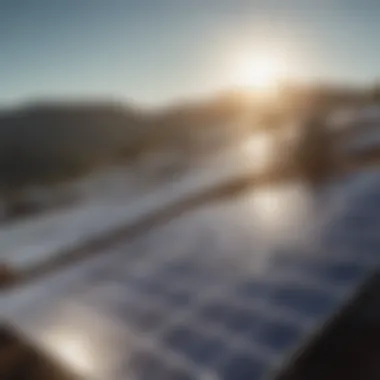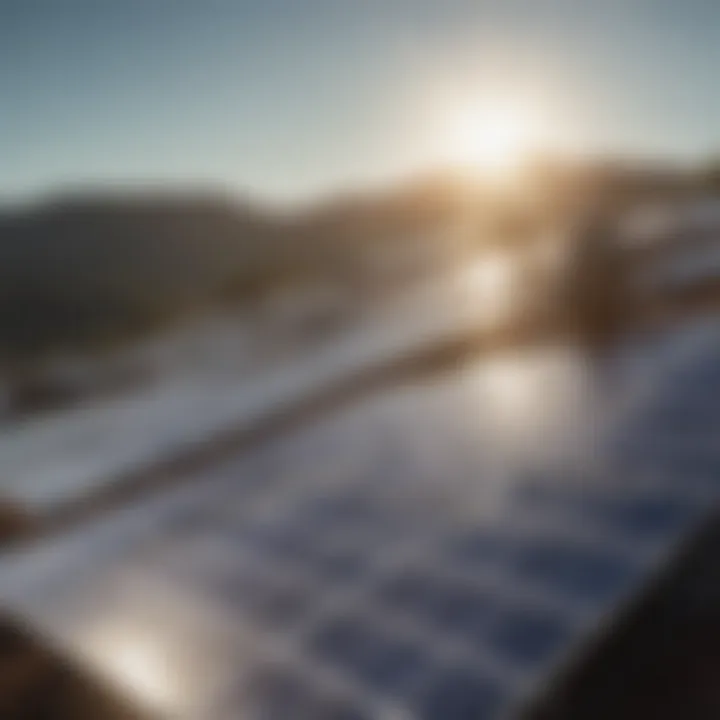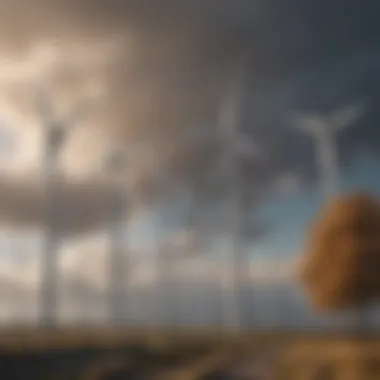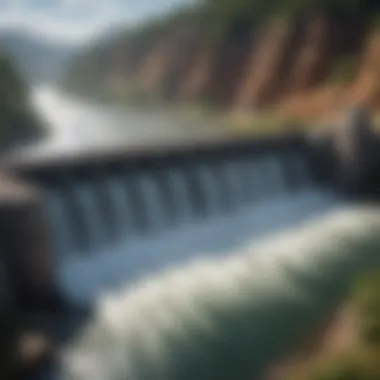Exploring the Three Types of Renewable Energy


Intro
The world today is pulsating with discussions about energy sources that don’t deplete our planet’s natural resources. As we venture deeper into the complexities of sustainable energy, three types shine brightly—solar, wind, and hydroelectric energy. Each represents not only a way to harness nature but also a step toward a sustainable future. Understanding these energy types can help investors and enthusiasts alike navigate the intricate realm of renewable energy.
Investment Terminology
In the domain of renewable energy, understanding investment terminology is crucial. A solid grasp of key terms can empower stakeholders to make informed decisions and spot opportunities in a rapidly evolving landscape.
Key Terms and Definitions
- Renewable Energy: Energy derived from natural resources that are replenished at a rate equal to or faster than consumption. Examples include sunlight, wind, and water flow.
- Photovoltaic (PV): Technology that converts sunlight directly into electricity using semiconductors.
- Feed-in Tariff (FiT): A policy mechanism designed to encourage the adoption of renewable energy through guaranteed payments to energy producers.
- Levelized Cost of Energy (LCOE): A measure used to compare the cost of different energy generation methods, factoring in total lifecycle costs divided by expected energy output.
Common Acronyms in Finance
- Finance in renewable energy can be dense with jargon, but here are fundamental acronyms you might encounter:
- CAPEX: Capital Expenditure, significant investments made in infrastructure to support renewable energy projects.
- OPEX: Operational Expenditure, ongoing costs for running a project after its initiation.
- PPAs: Power Purchase Agreements, contracts between energy producers and buyers outlining the terms of sale.
"Renewable energy is not merely a trend but a vital component for sustainable development across the globe. Understanding the language of finance can bridge the gap between innovation and implementation."
Expert Insights
As we dissect the nuances of each type of renewable energy, expert insights into investment strategies become valuable for both novice and seasoned investors.
Investment Strategies Overview
Investing in renewable energy often requires a well-rounded strategy. Here are a few paths investors might consider:
- Direct Investment: Buying shares or investing directly in companies leading the charge in solar panels or wind turbines.
- Mutual Funds or ETFs: These can provide broader exposure to renewable energy markets while minimizing risk by diversifying across various companies.
- Crowdfunding Projects: Platforms that allow individuals to invest in specific renewable energy projects, often at a lower capital threshold.
Tips from Financial Advisors
Financial advisors often stress the importance of due diligence when entering the renewable energy sector. Here are some practical tips:
- Stay Informed: The energy market is continually evolving, and keeping up with regulatory and technological changes can provide a competitive edge.
- Evaluate Long-term Viability: Investing in renewables requires a forward-thinking mindset; look for projects with solid futures.
- Consider Government Incentives: Be aware of the potential tax benefits and subsidies offered by governments to promote renewable energy projects.
By grasping the relevant terminology and strategies, you position yourself not just as an investor but also as a participant in a global movement towards sustainability. The realm of renewable energy, particularly solar, wind, and hydroelectric, offers myriad opportunities, reflections of an ever-changing world seeking a more sustainable path.
Prelude to Renewable Energy
In a world grappling with climate change and dwindling fossil fuel resources, understanding renewable energy becomes a necessity rather than a luxury. This section is the gateway to a comprehensive exploration of the three predominant types of renewable energy: solar, wind, and hydroelectric. Each energy source presents unique advantages and challenges that are essential not only for fostering sustainability but also for facilitating economic growth in a rapidly changing global landscape. Renewable energy is at the forefront of innovative solutions, addressing pressing issues such as energy security, pollution, and cost-effectiveness.
Defining Renewable Energy
Renewable energy refers to energy derived from resources that replenish naturally over short time scales. These sources include sunlight, wind, rain, tides, waves, and geothermal heat. Unlike fossil fuels, which are finite and will eventually be depleted, renewable energy sources can provide an ongoing supply of energy without adversely affecting the environment.
The concept of renewable energy encompasses several key characteristics:
- Sustainability: Renewable energy resources are sustainable, meaning they can be used repeatedly without the risk of running out.
- Environmental Impact: Utilizing renewable energy often results in lower carbon emissions, contributing to a reduction in air and water pollution.
- Economic Viability: As technology advances and the market grows, renewable energy systems are becoming more cost-competitive with traditional fossil fuels.
In this way, defining renewable energy goes beyond mere terminology; it encapsulates a broader movement towards an environmentally conscious and fulfilled society.
The Importance of Renewable Energy
The significance of renewable energy in today’s society is monumental. As cities expand and populations burgeon, the need for clean, reliable energy becomes more evident. Here’s why renewable energy is essential:
- Climate Change Mitigation: Transitioning to renewable sources can dramatically decrease greenhouse gas emissions, thus slowing down climate change.
- Energy Independence: Countries can reduce their reliance on foreign energy sources, improving national security and stability.
- Job Creation: The renewable energy sector is burgeoning, presenting numerous job opportunities—ranging from manufacturing to installation and maintenance.
"Investments in renewable energy not only hold promise for sustainable development but also promote diversification in energy generation, crucial in a rapidly evolving market."
As we continue our analysis in subsequent sections, the implications of these factors will become increasingly clear, leading us into a deeper understanding of how each type—solar, wind, and hydro—plays a role in shaping the future of energy.
Solar Energy
Solar energy has emerged as a front-runner in the race toward sustainable and renewable energy solutions. With an abundance of sunlight available almost everywhere on Earth, harnessing this natural resource is not only feasible, but also economically attractive. As countries work towards reducing their carbon footprints and meeting energy needs, solar energy offers a viable pathway that can accommodate both grassroots initiatives and large-scale projects.
In this section, we'll unpack the intricacies of solar energy, look at the various technologies available, assess the benefits and the hurdles faced, and project what the future may hold for solar applications.
Understanding Solar Energy
At its core, solar energy refers to the radiation emitted by the sun, which can be captured and converted into heat or electricity. This process is fundamental for providing power to residential, commercial, and industrial sectors. Different technologies are employed to harness solar energy, often categorized into two major approaches: photovoltaics and solar thermal energy.


One of the simplest ways to think of solar energy is akin to a sponge soaking up sunbeams, turning it into usable power. It reflects an innovative transition from fossil fuels to cleaner energy alternatives, going hand in hand with emerging technological advancements. The potential here is significant—not only can it decrease reliance on finite resources, but it can also lead to significant energy savings for users.
Types of Solar Technologies
Here, we delve into the principal technologies adopted in capturing solar energy, each with distinct methods of converting sunlight into usable energy.
Photovoltaic Systems
Photovoltaic systems convert sunlight directly into electricity using semiconductor materials, usually silicon. These systems are composed of solar panels that assemble modules to generate power.
What makes photovoltaics a popular choice is their versatility; they can be installed in various settings— from rooftop systems on homes to solar farms spanning acres of land. The installation costs have also seen a downward trend in recent years, making it more accessible for the average consumer.
The main advantage of these systems is their capacity to generate electricity even on cloudy days. However, they do face challenges, like efficiency losses at high temperatures and significant land use in large installations. Despite these challenges, photovoltaics are a cornerstone in the renewable energy landscape.
Solar Thermal Systems
Solar thermal systems capture sunlight to produce heat, which is then used for a variety of applications, such as water heating or space heating. These systems utilize solar collectors placed on rooftops or open spaces to gather sunlight and convert it into thermal energy.
The benefit here is substantial in residential settings where users need hot water, especially in regions with high sunshine. One unique feature of solar thermal systems is their ability to store heat for use during periods without sunlight, typically implemented by using insulated tanks. Yet these systems might not be as efficient in colder regions and depend heavily on consistent sunlight.
Concentrated Solar Power
Concentrated Solar Power (CSP) uses mirrors or lenses to focus a large area of sunlight onto a small beam. This concentrated energy heats up a fluid, which produces steam to drive a turbine connected to an electricity generator.
The key characteristic of CSP is its scalability. These systems are typically installed in solar farms and can generate a large amount of electricity, making them suited for grid applications. They provide a robust solution for power generation during peak sun hours. However, CSP installations can be expensive and require a substantial initial investment, which can be a barrier for some.
Advantages of Solar Energy
The benefits of solar energy are manifold, often outweighing the initial installation costs. Here are some of the key advantages:
- Environmentally Friendly: Solar energy is a clean source of energy that decreases greenhouse gas emissions.
- Energy Independence: Adoption of solar technologies can reduce dependence on imported fuels.
- Job Creation: The solar sector has seen immense growth, resulting in job creation in various fields, from manufacturing to installation.
- Low Operating Costs: Once installed, the ongoing maintenance and operational costs are typically low.
Challenges in Solar Energy Implementation
While solar energy holds great promise, there are challenges that come with its implementation:
- High Initial Costs: Although prices have reduced significantly, the upfront costs can still deter potential users.
- Intermittent Energy Source: Solar energy generation is weather-dependent and varies during the day and between seasons.
- Space Constraints: Large installations require significant land use, which may not be feasible in urban settings.
Future Trends in Solar Energy
Looking forward, the solar energy landscape is expected to evolve with several trends on the horizon:
- Technological Advancements: Innovations in battery storage and smart grids could improve efficiency.
- Decentralized Energy Systems: Small-scale installations and community solar programs aim to distribute energy sources.
- Policy Support: Governments worldwide are increasingly providing incentives to adopt renewable technologies.
Wind Energy
Wind energy stands as a key pillar in the renewable energy landscape. Its potential not only lies in generating electricity but also in driving economies and enhancing energy independence. The sheer availability and power of wind make it a favorable alternative to fossil fuels. Unlike their non-renewable counterparts, wind resources are abundant and persistent across many regions globally, leading to decreased reliance on finite resources.
Mechanics of Wind Energy
At its core, wind energy mechanics revolves around harnessing the contrast in atmospheric pressure, which causes air to move from high to low-pressure areas. This movement is what we call wind, and the strength of this wind translates into kinetic energy. Convert this kinetic energy into electrical energy using wind turbines, and you have the basic principle of how wind energy works. The efficiency and effectiveness of this conversion process can vary based on several factors, including turbine design and wind speed.
Wind Turbine Technology
The heart of wind energy is the turbine technology, primarily categorized into two types: Horizontal-Axis and Vertical-Axis wind turbines.
Horizontal-Axis Wind Turbines
Horizontal-Axis Wind Turbines (HAWTs) are the most common type seen today. They consist of three blades mounted on a tall tower. What makes HAWTs particularly effective is their ability to capture wind at various angles, optimizing energy generation as wind speeds change throughout the day. The height of the tower plays an important role, with winds generally increasing in speed with altitude. The turbine's design enables them to be easily scaled for larger projects, maximizing energy output.
Key characteristics include:
- Greater efficiency due to higher wind capture capabilities.
- Acceptance in large wind farms due to their scalability.
One downside is their reliance on specific wind conditions which can lead to inefficiencies during lower wind speeds; yet, their overall contribution to the energy grid is significant, making them a cornerstone in wind technology discussions.
Vertical-Axis Wind Turbines
In contrast, Vertical-Axis Wind Turbines (VAWTs) have blades that rotate around a vertical axis. They are often thought of as the underdogs in wind technology, but they have unique advantages. For instance, VAWTs can capture wind from any direction, which is advantageous in turbulent airflows.
Key characteristics include:


- Generally beneficial for locations with variable wind direction.
- Usually quieter and potentially less visually intrusive due to smaller size.
However, their lower efficiency compared to HAWTs can be a drawback, especially in wind-rich areas where maximizing energy output is crucial. They serve well in urban settings or small-scale installations but are often overshadowed by the more popular HAWTs when it comes to large wind farms.
Benefits of Wind Energy
The advantages of wind energy are substantial. For one, wind energy significantly reduces greenhouse gas emissions when compared to fossil fuel energy generation, promoting a cleaner environment. Moreover, operational costs are relatively low once a wind farm is established, leading to lower electricity prices for consumers.
- Renewable and Abundant: Harnessing wind generates energy without depleting resources.
- Job Creation: The wind energy sector is rapidly growing, which creates numerous jobs ranging from manufacturing to maintenance.
- Rural Development: Wind farms often crop up in rural areas, injecting money into local economies.
- Energy Independence: Countries can reduce their reliance on imported fuels, boosting national security.
Barriers to Wind Energy Adoption
Despite its benefits, several barriers slow the adoption of wind energy. Initial costs of setup can be high, especially for large wind farms. Some other challenges include:
- Land Use Conflicts: Locating new wind farms often encounters resistance from local communities.
- Intermittency Issues: Wind is not a constant source; it can lead to reliability concerns in energy supply.
- Infrastructure Needs: Upgrading existing electricity grids to support renewable energy resources often comes at a hefty price.
Emerging Trends in Wind Energy
As technology evolves, new trends emerge that shape the future of wind energy. Innovations in turbine efficiency promise to harness wind even more effectively, while floating wind farms expand possibilities in oceans and lakes. Also, the integration of AI and predictive analytics into wind farm operations can enhance energy management and maintenance schedules.
"The evolution of wind energy signifies a decisive turning point in our approach to sustainable energy."
Staying attuned to these developments is essential for investors, policymakers, and consumers who strive to harness the power of wind for a sustainable future.
Hydroelectric Energy
Hydroelectric energy is pivotal in the broader conversation of renewable energy, slicing right through the noise around sustainability and environmental challenges. This form of energy harnesses the power of flowing water, translating natural dynamics into electrical output. Hydroelectricity accounts for a large chunk of the world’s renewable energy matrix, enhancing energy security while keeping carbon footprints at bay.
Principles of Hydroelectric Energy
At the core of hydroelectric power is a fairly straightforward principle: gravity. When water flows downhill, the kinetic energy it generates can be captured and converted into electricity. Dams are often employed to create reservoirs which store water. When released, this water spins turbines connected to generators, making sure that we get a steady flow of electrical energy ready for consumption.
Types of Hydroelectric Facilities
Run-of-River
Run-of-river facilities are quite unique since they rely on the natural flow of river water to drive turbines. Unlike traditional dam operations, they do not store vast quantities of water; instead, they divert a portion of the river’s flow. This can be notably beneficial in maintaining local ecosystems and reducing methane emissions—a welcomed trait in our environmentally-conscious age. One main characteristic is its lower environmental impact compared to large dams. However, its output can be inconsistent as it’s directly tied to river flow levels.
Storage
Storage hydropower plants take a different approach by employing reservoirs to hold significant volumes of water. This enables them to generate power on demand, adjusting to the fluctuating need for electricity. A standout feature is the operational flexibility it offers. However, the trade-off can be quite substantial in terms of environmental footprint, as the creation of reservoirs may lead to habitat disruption.
Pumped Storage
Pumped storage plants essentially work as giant batteries. Water is pumped uphill during low demand periods, and then released to generate electricity when demand peaks. Its capacity to act as a load balancer for energy grids gives it a special place in the renewable energy dialogue. What makes it appealing is its efficiency in energy usage, but the upfront costs associated with constructing such facilities can be a sticking point for potential investors.
Advantages of Hydroelectric Energy
The advantages of hydroelectric energy come with a repertoire. They include:
- Renewable Source: As long as the water cycle continues, hydroelectric energy remains viable.
- High Efficiency: Conversion rates are typically above 90%.
- Job Creation: Construction and maintenance of facilities provide local employment opportunities.
Environmental Considerations in Hydroelectric Power
While hydroelectricity is relatively cleaner, it’s not without its environmental toll. Considerations involve:
- Impact on Aquatic Life: Dams can obstruct migration routes for fish.
- Ecosystem Changes: Reservoirs can alter local flora and fauna dynamics.
Future of Hydroelectric Energy
As we peer into the future, the potential for hydroelectric energy is immense. Advances in technology could lead to more environmentally friendly infrastructure, including fish-friendly turbines or innovative designs that harmonize human energy needs with ecological preservation.
In summarization, hydroelectric energy stands firm as a cornerstone in the renewable arena, a means of not just power generation but a potential pathway to more sustainable energy practices.
Hydroelectric energy contributes substantially to reducing greenhouse gas emissions and fostering sustainable investment opportunities.
The continuous development of clean technologies and the sensitivity toward environmental implications indicate that hydroelectric energy can play a transformative role in the future of our energy landscape.
Comparative Analysis of Renewable Energy Types
In the realm of energy production, understanding the distinctive features and advantages of various renewable energy sources is crucial for both policymakers and investors alike. This comparison helps identify not just the strengths and weaknesses of solar, wind, and hydroelectric energy, but also how these sources can work together in a complementary manner. By examining elements such as cost-effectiveness, scalability and efficiency, and long-term sustainability, stakeholders can make informed decisions that align with financial goals and environmental aspirations.


Cost-Effectiveness
When we talk about cost-effectiveness in renewable energy, it’s important to consider multiple factors, such as initial investment, operating costs, and return on investment. Solar energy, for instance, has seen a significant drop in installation costs over the past decade due to advancements in technology and manufacturing processes. This trend has made solar photovoltaic systems more accessible to both residential and commercial users.
- Average Costs: On average, residential solar installations now range from $15,000 to $30,000 before incentives, with the payback period generally falling between five to seven years.
- Long-term Savings: After the initial costs, solar energy provides significant savings on electricity bills, with some homeowners reporting up to 100% reduction, depending on their usage and system size.
Wind energy also boasts economical advantages, particularly in regions with favorable wind patterns. The levelized cost of energy (LCOE) for onshore wind has dropped below that of fossil fuels in many areas. Yet, investing in wind farms also comes with considerations of land lease agreements and maintenance costs for turbines.
"Cost effectiveness doesn’t just mean affordability; it’s about achieving the best outputs for the inputs."
Based on these insights, hydroelectric energy typically has higher upfront costs due to the construction of dams and infrastructure. However, once established, these facilities can generate consistent and predictable energy for decades, effectively spreading out initial costs over a long lifetime.
Scalability and Efficiency
Scalability refers to the potential of a renewable energy technology to grow in capacity and size, which is essential for meeting the increasing global energy demands. Here’s how different types stack up:
- Solar Energy: One of the most scalable renewable resources. From small rooftop panels to large-scale solar farms, the modular nature of solar technology allows for gradual expansion. This adaptability is attractive for investors looking to minimize risk while maximizing returns.
- Wind Energy: Onshore wind farms can be built incrementally, starting with just a couple of turbines and expanding as demand grows. Meanwhile, offshore wind has massive potential but involves more complexity and upfront investment due to infrastructure challenges.
- Hydroelectric Energy: Though typically requiring larger initial projects, there’s potential for smaller run-of-river projects, which have less environmental impact compared to traditional dam projects. However, scalability can be limited by geographical constraints.
Efficiency is another key metric. Solar panels have seen remarkable improvements, with some models achieving efficiencies over 22%. Wind turbines also utilize technology advancements to harness wind more effectively, while hydroelectric facilities are known for their high operational efficiencies, often reaching 90%.
Long-Term Sustainability
Long-term sustainability examines not just the viability of energy sources but their overall impact on the environment and society. Renewable energy must not only provide electricity but do so in a way that is sustainable over the long haul.
- Solar Energy: Solar technology has a relatively low environmental footprint once operating. However, the lifecycle assessments of silicon production and disposal need scrutiny as the industry matures.
- Wind Energy: Wind’s sustainability is notable, promoting land use that can integrate agriculture and other activities. Nevertheless, concerns about wildlife, particularly bird and bat mortality, could impact long-term acceptance.
- Hydroelectric Energy: While hydroelectric power is dependable, it poses significant ecological impacts, including habitat alteration and fish migration disruption. Sustainable practices in dam management are essential to mitigate these effects.
Thus, implementing renewable energies is not just about choosing the cheapest option but understanding how each source contributes to a sustainable future. Investors looking to navigate this landscape can benefit by weighing these critical factors against their specific goals, environmental considerations, and market trends.
Impact of Renewable Energy on Investment Strategies
The conversation around renewable energy goes beyond just the environment. It's an evolving landscape where financial opportunities are abundant. For investors, understanding the impact of renewable energy on investment strategies is crucial. This insight shapes how the market operates and dictates where capital flows. In essence, investing in renewable energy isn't just about supporting sustainability; it's about seizing potential financial gains in a rapidly shifting market.
Financial Incentives for Renewable Projects
Various governments and institutions have rolled out an array of financial incentives to boost the growth of renewable energy projects. These incentives serve as a safety net, helping mitigate some risks associated with initial investment costs. Common forms of financial incentives include:
- Tax Credits: Many jurisdictions offer tax breaks for investments in solar, wind, or hydroelectric projects. These credits can significantly reduce the tax burden.
- Grants and Subsidies: Local, state, or federal grants can lower the overall cost of projects, making capital investments more attractive.
- Feed-in Tariffs: Guaranteed payments for energy produced can offer a steady, reliable revenue stream, thus enhancing financial viability.
The allure of these incentives often leads investors to venture into renewable projects. For example, the Solar Investment Tax Credit in the U.S. allows investors to deduct a substantial percentage of their investment from federal taxes, encouraging more people to go solar.
Investment Risks and Returns
Every investment carries risk, and renewable energy is no exception. While it’s a burgeoning field with immense potential, certain pitfalls could trip up even seasoned investors. Here are a few considerations:
- Market Volatility: The renewable energy sector has its ups and downs. Changes in regulations or technological advancements can quickly alter market dynamics.
- Development Risks: Projects can face delays due to permitting issues, environmental concerns, or community opposition. These hindrances can hurt timelines and profits.
- Return on Investment (ROI): The ROI for renewable energy can vary widely. While long-term gains can be enormous, the initial phase often entails higher financial outlays and waiting periods.
It's crucial for investors to adopt a nuanced approach, weighing potential returns against these risks. A wise strategy could involve diversifying investments across various segments—solar, wind, and hydro—to buffer against sector-specific downturns.
Market Trends Shaping Renewable Investments
The landscape of renewable energy investments is not static; it transforms with market forces and societal shifts. Observing these trends can help investors capitalize on fresh opportunities. Key trends include:
- Increased Corporate Investment: Major corporations are moving towards sustainability by investing in renewable sector initiatives. Companies like Apple and Google are gradually powering operations with 100% renewable energy, creating a ripple effect in investment patterns.
- Technological Advancements: Innovations in energy storage and efficiency are making renewable technologies more accessible and economically viable. Battery technologies, like those used in Tesla's products, signal a promising future for energy retention and consumption.
- Green Bonds: The rise of green financing has opened doors for investments specifically earmarked for environmental projects. Investors seeking to align their portfolios with sustainable metrics find this appealing.
"Investors today are not just looking at numbers; they're also considering the impact of their investments on the planet."
Culmination
The journey through the multifaceted world of renewable energy has illuminated the significant role it plays in our society today. It's not merely about finding alternatives to fossil fuels; it's about redefining our relationship with energy and paving the path for sustainable futures. This conclusion aims to distill the essence of what renewable energy signifies, focusing on its profound impact, advantages, and considerations moving forward.
Revisiting the Importance of Renewable Energy
The importance of renewable energy cannot be overstated. As the call for sustainable practices grows louder, so does the need for energy that minimizes environmental impact. By harnessing solar, wind, and hydroelectric resources, we can reduce greenhouse gas emissions and combat climate change.
Moreover, renewable energy fosters energy independence. Countries investing in these technologies are often less reliant on imported fuels, providing them with greater energy security. There’s also a growing awareness that transitioning to renewables is a viable pathway to job creation, ultimately boosting local economies.
- Cleaner Environment: Reduced carbon footprint is beneficial for air and water quality.
- Sustainable Growth: Promotes economic diversification and can reduce energy costs in the long run.
- Innovation Drive: This sector encourages innovation, which often leads to new job categories and specializations.
"Investing in renewable energy isn't just a choice; it's essential for a sustainable world where our children can thrive."
The Path Forward in Renewable Energy Development
So, what’s next for renewable energy? The path forward isn't without hurdles, but the landscape is changing rapidly. Continued advancements in technology are reducing costs and increasing efficiency in renewable energy systems. Battery storage technology, for example, is becoming key in managing the intermittent nature of solar and wind energy.
As we envision the future, collaborative efforts between governments, industries, and communities will be crucial. Strong policy frameworks encouraging investment in renewable energy will play a pivotal role in scaling these solutions.
- Investment in Education: Fostering a skilled workforce through education tailored towards renewable technologies ensures a knowledgeable base ready to tackle upcoming challenges.
- Public-Private Partnerships: Increased collaboration can lead to new project funding, innovation, and quicker implementation of renewable systems.
- Global Cooperation: The fight against climate change transcends borders. International agreements can facilitate knowledge transfer and technological shared advancements.
As we look forward, the drive toward renewable energy is not merely a trend; it is a necessity for untangling ourselves from past practices that have harmed our planet. Engaging in dialogues, investing wisely, and adopting sustainable practices isn't just the future we envision; it's the future we must create.















